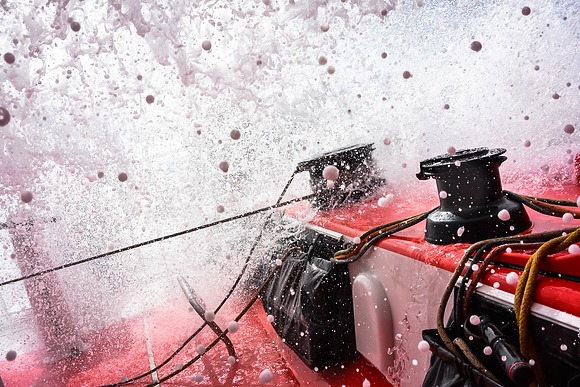As the wind dropped last night, the team onboard Dongfeng had another ‘near miss’ experience which could have had dire consequences. With regular reports from the boat about the pain and pleasures of offshore sailing, today’s update is proof of just how dangerous crossing the busy North Atlantic ocean can be.
It is often said that when competing in the Volvo Ocean Race you need to have eyes in the back of your head 24/7, and last night this was certainly true for Dongfeng’s Skipper, Charles Caudrelier. Not only is Charles responsible for the multi-million Euro racing yacht, the new Volvo Ocean 65, but as skipper he is also responsible for his crew. Their safety is at the forefront of everything he does, especially whilst crossing the Atlantic with four relatively inexperienced crew on board.
“Yesterday we were afraid because there was a big cargo ship heading straight for us [in the dark],” reported Caudrelier. “I think the guy [Watchkeeper on the cargo ship] must have been sleeping or something because he wasn’t paying attention. I tried calling and calling but there was no answer. We were sitting in the ocean with barely any wind and only 7 knots (12kph) of speed so could not easily manoeuvre, and this huge ship was coming at us at about 20 knots (37kph). Luckily he passed us at about 100m away but I was so angry with him! I called and called but no answer – it was not a Maersk ship so that’s ok!”
For onboard reporter Allan Lan, this was another first time experience: “Charles’ frustration of not being able to contact the vessel was apparent to the whole team. He was speaking rapidly in French and repeatedly trying to call. We were lucky that it passed us at 100m which sounds a lot but in the middle of the ocean, with a giant cargo ship bearing down on you, I promise you it’s not.”
The team were quickly over the incident and the focus returned to sailing. There is a big low pressure weather system ahead of Dongfeng with winds forecasted at up to 45 knots (83kph). However, the team will avoid getting too close to the centre of the low where the strongest wind is: “We are training not racing,” explained Charles. “It is important not to damage the boat at this point, we still expect to hit some hard winds but hopefully not as much as 45 knots and we expect waves of about 4 metres.” To watch the full video click here.
You can follow the team’s progress on all social media channels and the team’s official website:
Facebook: Click here
Twitter: Click here
Instagram: Click here
Youtube: Click here
Official website: Click here
Official Tracker: Click here
During the past 24 hours Dongfeng Race Team have experienced some fantastic training conditions. Since the start of the transatlantic, Caudrelier and his crew have had their fair share of ups and downs, but now exactly a week into the crossing they are proving stronger than ever.
“It was another great day for the team yesterday, with more than 450 nautical miles covered,” explains Team Director Bruno Dubois,“They are currently chasing a storm just north of their location and as Charles explained yesterday they want to be careful not to damage the boat at this stage, and so far they have managed to stay on the edge of the storm where the wind is averaging 20-25 knots. If they were to move closer to the eye of the storm they would no longer be in ‘training’ mode but ‘survival’ mode. Sailing consistently at 25 knots, the way they are, is a great test for the team as a whole and the crew as individuals.”
When sailing at this speed the conditions onboard are pretty wet and wild which result in plenty of water and enormous waves crashing over the deck. One wave was so powerful it completely took out the EPIRB (Emergency Position Indicating Radio Beacon) and within seconds left it floating in the Atlantic miles behind the boat. The EPIRB automatically emitted an emergency signal that is picked up by a satellite and relayed to the ground control station, in this case the coastguard who immediately informed the shore team manager. The only difference between an EPIRB signal and a Mayday signal is that the EPIRB is activated automatically when it is fully submerged in water, which doesn’t result in any action from the crew, whereas a Mayday distress signal is sent manually through the VHF radio onboard by the crew. Both have equal levels of importance.
“We knew immediately that the boat and crew were okay because the tracker showed us they were still moving at 20 knots, which would not be the case if they’d had a problem of any sort,”explained Graham Tourell from the shore team. “They are blasting along on port tack, broad reaching in around 25kts of wind so when you get a wave coming at you over the side of the boat, it hits incredibly hard!
“We were hot on the phone to a surprised Charles who told us he had no idea the EPIRB was gone!”
Although the team suspect a wave swept the EPIRB away, it could have simply shaken itself off, as the boat is bouncing around violently. “It’s like standing on the roof of a Paris Dakar rally car!”describes Tourell.
The latest ETA for the team in Lorient is Monday early afternoon. The weather conditions are expected to become a little trickier closer to France with more variable winds forecasted. Upon completion of this transatlantic, the crew will have covered over 10,000 miles with the boat since the start of the Dongfeng Race Team project.


